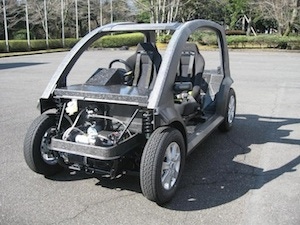April 4, 2011

The drive toreduce weight for electric cars is demanding creative new materials' concepts.
In one example, Teijin developed anelectric-vehicle (EV) concept car that features a frame made entirely fromthermoplastic CFRP and weighs only 103.4 lb, or roughly one fifth the weight ofa conventional automobile's cabin frame. The four-seat EV is capable of speedsup to 37 mph and has a cruising range of 62 miles.
Electric Vehicle Designs Spur New Materials' Approaches_A |
The CFRPinnovation fits into a revised and amped-up R&D strategy at the TeijinGroup. "In order to deal with rising nations, we must conduct research anddevelopment in a more efficient manner and at a faster pace and to respond morepromptly to the changing market environment," says Toshiaki Yatabe, chieftechnology officer for Teijin.
In another example, Winzeler Gear, based in HarwoodHeights, IL, and one of America's three largest plastics gear molders,engineered polyacteal transmission gears for an Ultra Light Urban Vehicleproject.
Thebrainchild of Martin Morris, professor of mechanical engineering at BradleyUniversity, is a vehicle that features just three wheels and is licensed as amotorcycle that carries two people, baggage and weighs 430 lb. It offersregenerative braking, a top speed of 45 mph and a range of 40 miles.
"Traditionalistswould say harsh transmission applications preclude POM," says Tim Brogla,program developer, DuPont Performance Polymers, which supplied polyacetal forthe gears "Clearly, this project challenges some of those 'absolutes;' itdoesn't require a leap of faith to see these gears in small enginetransmissions, such as riding lawn mowers and golf carts."
In a thirddemonstration project, the body of the electric WindExplorer is made primarily of carbon fiber reinforced plastic (CFRP)composite that surrounds a light weight structural foam core called Rohacell.Its lithium-ion batteries are charged by a mobile wind turbine or-inexceptional cases-in the conventional manner from the power grid.
Rohacell technology from Evonik is a polymethacrylimide(PMI) rigid foam that is used in aircraft, helicopters, trains and ships, andis gaining ground in automotive construction. It allows weight savings of 60percent compared to standard steel parts.
About the Author(s)
You May Also Like






